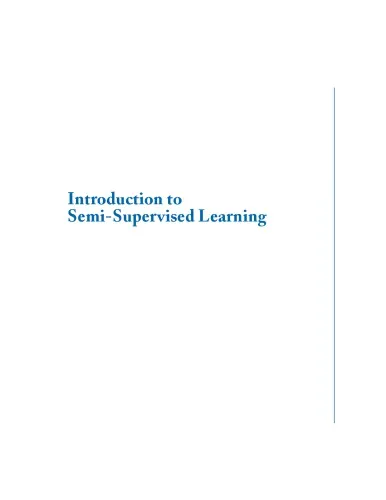Introduction to semi-supervised learning
4.5
Reviews from our users

You Can Ask your questions from this book's AI after Login
Each download or ask from book AI costs 2 points. To earn more free points, please visit the Points Guide Page and complete some valuable actions.Introduction to Semi-Supervised Learning
Introduction to Semi-Supervised Learning by Zhu X. and Goldberg A.B. is a foundational work that addresses one of the most critical challenges in modern machine learning: how to effectively utilize vast amounts of unlabeled data alongside limited labeled data to improve model performance. This book is a pioneering exploration of semi-supervised techniques, offering readers both theoretical underpinnings and practical methodologies. The text targets researchers, data scientists, and machine learning practitioners who aim to advance their understanding of this burgeoning field.
Detailed Summary of the Book
In the realm of machine learning, labeled data is often scarce and expensive to acquire, while unlabeled data is abundantly available but underutilized. This book provides a comprehensive overview of semi-supervised learning (SSL), a paradigm that bridges this gap by making use of both labeled and unlabeled data.
The book opens by establishing the theoretical foundations of semi-supervised learning, including generative models, low-density separation, and graph-based techniques. These frameworks illustrate how unstructured, unlabeled data can be integrated into the learning process. Zhu and Goldberg delve into a variety of algorithms, covering both traditional and emerging methods, to showcase the evolution of the field.
Each topic is meticulously explained using mathematical formulations and real-world examples. The authors address challenges such as model validation, bias, and error propagation, ensuring that readers grasp the nuances of applying SSL in practice. Beyond technical insights, the book provides guidance on evaluating models, experimental design, and implementation strategies suitable for different domains, such as natural language processing, computer vision, and bioinformatics.
Key Takeaways
- Labeled data is invaluable but often limited; semi-supervised learning effectively bridges the gap by leveraging abundant unlabeled data.
- Semi-supervised learning is founded on diverse approaches, including generative models, graph-based frameworks, and low-density separation.
- SSL has practical applications across fields such as healthcare, autonomous driving, language processing, and beyond.
- The challenge of evaluating semi-supervised models and mitigating potential biases in learning warrants deeper research and innovation.
- Understanding the balance between labeled and unlabeled data is critical for optimizing SSL algorithms and achieving state-of-the-art results.
Famous Quotes from the Book
"In semi-supervised learning, the power lies not in how much labeled data you have, but in how effectively you leverage what you don’t."
"Unlabeled data is a treasure chest of information—semi-supervised learning simply provides the key."
"Semi-supervised learning challenges the traditional dichotomy of labeled versus unlabeled data, uniting them for a common goal."
Why This Book Matters
Semi-supervised learning is rapidly becoming one of the most influential topics in machine learning, as the explosive growth of data demands more efficient and scalable learning approaches. This book holds immense value for researchers and practitioners who seek to advance in a competitive and evolving landscape.
The importance of this book extends beyond its academic rigor—it equips readers with practical tools and concepts to tackle real-world problems where labeled data may be scarce. By providing both breadth and depth in its coverage, the authors ensure that novices and experienced professionals alike find value in its pages.
Furthermore, this book pushes readers to think critically about the ethical and computational challenges of working with partially labeled datasets. It lays a foundation for future advancements in the field, as well as inspires innovation in learning from incomplete or imbalanced data sources.
Ultimately, Introduction to Semi-Supervised Learning is not just a technical manual—it is a guide to rethinking how we approach data and learning in an age of information overload. Its lasting impact on both theory and practice cements its place as a cornerstone in machine learning literature.
Free Direct Download
You Can Download this book after Login
Accessing books through legal platforms and public libraries not only supports the rights of authors and publishers but also contributes to the sustainability of reading culture. Before downloading, please take a moment to consider these options.
Find this book on other platforms:
WorldCat helps you find books in libraries worldwide.
See ratings, reviews, and discussions on Goodreads.
Find and buy rare or used books on AbeBooks.
Questions about Book
1156
بازدید4.5
امتیاز50
نظر98%
رضایتReviews:
4.5
Based on 0 users review
"کیفیت چاپ عالی بود، خیلی راضیام"
Questions & Answers
Ask questions about this book or help others by answering
No questions yet. Be the first to ask!


